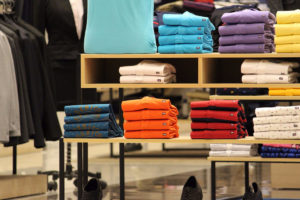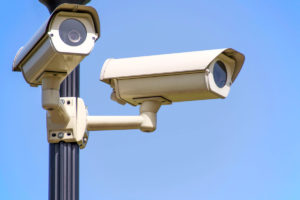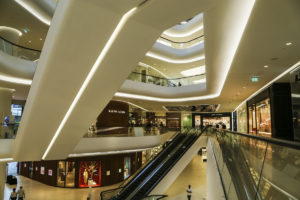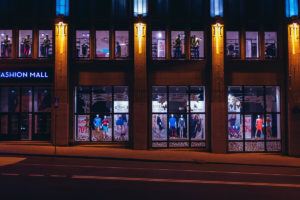 Retail shelving along with store design has a huge impact on shoplifting losses. Typically a shoplifter likes and needs privacy even if only for a moment. So why not keep that in mind when designing or remodeling your store. Your shelving and isles can work for you by simply considering several factors.
Retail shelving along with store design has a huge impact on shoplifting losses. Typically a shoplifter likes and needs privacy even if only for a moment. So why not keep that in mind when designing or remodeling your store. Your shelving and isles can work for you by simply considering several factors.
Shelving height can be critical. It may be tempting to have shelves go all the way to the ceiling. However, this creates cover for shoplifters. They feel more secure when they cannot be seen. Shelving that allows your staff to see over and keep track of customers make a shoplifter uncomfortable.
Do not create dead sports. Shoplifters will pick up your merchandise and head for “dark areas” of your store. Areas when they can remove packaging, pricing… and have time to conceal it.
Speaking of lighting. Make sure that you align lighting with your isles. Not only will that encourage sales but again, adequate lighting will not allow shoplifters to get comfortable.
You should also put some thought into your end cap displays. Move small or high value merchandise to end caps that are easily seen by your staff. Likewise place merchandise that is larger and lesser value on end caps that face away from staff.
When designing your stores’ layout consider the foot traffic of staff, customers and shoplifters. We want retail staff and even back office personnel to routinely visit all areas of the store. It may be tempting to have a single direct path but that could leave a number of areas rarely visited by staff throughout the day. That is a gold mine for shoplifters. They watch staff traffic and will naturally migrate to areas less traveled.
Likewise you want your good customers to assist you with shoplifting prevention. They can do this in two ways. If your store is laid out in such a way that keeps legitimate customers spread out and in all areas of the store not just focused in one or two places, then they help you with removing privacy from the shoplifter.
Another technique to shut off shoplifters is to make your legitimate customers into your store security, without the customer even knowing it. You can use a PA system or even radios that can be heard by the public (not on a headset) for this.
To do this make a “ghost call”. If you suspect that shoplifters are in the store then on the PA system say “security to section 3…,” then watch what happens! Legitimate customers will not care, they are not in the mindset to steal. They are focused on what they are looking at. At most they may look up and around, then simply go back to what they were doing. Shoplifters on the other hand will react differently. By calling security to an “area” that is not marked or corresponds to anything such as isle number… the shoplifter does not know what is going on. And that legitimate customer that then happens to come into the isle or area they are in now becomes an undercover store detective regardless of age, gender…. You can even assign ghost calls to staff as a responsibility to be made randomly every hour or so.
All of this because of a little forethought on your part and shelving design help.
Bill Bregar is a 30+ year loss prevention expert. Bill was the Director of Loss Prevention for several major retailers and is now the President of Loss Prevention Systems, Inc. LPSI specializes in Checkpoint Systems anti-shoplifting equipment. He has personally apprehended many shoplifters and over 2300 employees stealing from their employers. Bill can be reached at: [email protected] or at 770-426-0547
 Loss Prevention Officers and Managers catch shoplifters and dishonest employees. That is a common perception and in some stores it may be a true picture of what Loss Prevention departments do, with the additional caveat that they may have uniformed people who conduct receipt checks. If this is all that the department does it can be hard to sell store managers on the value of having them on staff if the budget for them comes directly from the store. It is even more difficult for small, independent retailers to justify hiring a Loss Prevention Officer although if the store is in a high crime area they may contract a security guard. There was a time when there was an “us versus them” mindset between store managers and Loss Prevention teams. Over time some larger companies have focused their Loss Prevention teams more on operational issues. For example, I worked for a company that had Loss Prevention conduct food product out of date audits. Their position was that this was a safety issue so it fell to the Loss Prevention team. I had no problem doing the audits, but as I looked at the amount of out of date items I was finding I had to question what the freight team was doing when they were stocking. Who was auditing their work because there were a lot of FIFO (First In First Out) issues I was identifying that were causing out of date problems.
Loss Prevention Officers and Managers catch shoplifters and dishonest employees. That is a common perception and in some stores it may be a true picture of what Loss Prevention departments do, with the additional caveat that they may have uniformed people who conduct receipt checks. If this is all that the department does it can be hard to sell store managers on the value of having them on staff if the budget for them comes directly from the store. It is even more difficult for small, independent retailers to justify hiring a Loss Prevention Officer although if the store is in a high crime area they may contract a security guard. There was a time when there was an “us versus them” mindset between store managers and Loss Prevention teams. Over time some larger companies have focused their Loss Prevention teams more on operational issues. For example, I worked for a company that had Loss Prevention conduct food product out of date audits. Their position was that this was a safety issue so it fell to the Loss Prevention team. I had no problem doing the audits, but as I looked at the amount of out of date items I was finding I had to question what the freight team was doing when they were stocking. Who was auditing their work because there were a lot of FIFO (First In First Out) issues I was identifying that were causing out of date problems.

 I don’t know how many times I have heard it, but I have heard it said that shoplifting is not a crime that is premeditated. I have heard and read the arguments that dismiss the seriousness of the crime and portray the criminals as opportunists acting on the spur of the moment. Implicit in the argument is the minimizing of the extent of Organized Retail Crime rings as well as the willingness of shoplifters to steal from your customers. I have even had people who think along these lines voice their disapproval when I had shoplifters I had apprehended and was walking to my security office. I recall one occasion when I apprehended three young men, about 14 years of age and was by myself. I had them stand with their faces against the wall as I had to get my keys out to unlock the door to my office. Two men were sitting outside my office and one muttered under his breath that I was being a butt, only he used a more colorful adjective. I looked at him and told him to mind his own business. The point is that there are people more sympathetic to the criminals than retailers and see shoplifting as a minor infraction at worst and mischievous behavior at best. The attitude among those that hold to those beliefs might change if they realized that these shoplifters aren’t necessarily choosy about who they steal from. They also don’t consider the safety risks posed by the careless acts of these criminals.
I don’t know how many times I have heard it, but I have heard it said that shoplifting is not a crime that is premeditated. I have heard and read the arguments that dismiss the seriousness of the crime and portray the criminals as opportunists acting on the spur of the moment. Implicit in the argument is the minimizing of the extent of Organized Retail Crime rings as well as the willingness of shoplifters to steal from your customers. I have even had people who think along these lines voice their disapproval when I had shoplifters I had apprehended and was walking to my security office. I recall one occasion when I apprehended three young men, about 14 years of age and was by myself. I had them stand with their faces against the wall as I had to get my keys out to unlock the door to my office. Two men were sitting outside my office and one muttered under his breath that I was being a butt, only he used a more colorful adjective. I looked at him and told him to mind his own business. The point is that there are people more sympathetic to the criminals than retailers and see shoplifting as a minor infraction at worst and mischievous behavior at best. The attitude among those that hold to those beliefs might change if they realized that these shoplifters aren’t necessarily choosy about who they steal from. They also don’t consider the safety risks posed by the careless acts of these criminals. There seems to be an advice website or YouTube video for nearly everything these days. Want to know who to call for home repairs? Need information about a car before you buy it? Looking for someone to date? Yes, it’s all on the internet, I’ve even completed some plumbing repairs and small vehicle repairs with the aid of online videos. Unfortunately, while there is a lot of help and good information on the world wide web, there are also sites that purport to be “informational” only but the information they provide supposedly tells people how to shoplift. What I find even more irritating is that some of these theft websites allegedly are written by former Loss Prevention personnel. The information they give is sometimes too accurate and could cause problems for a retailer who isn’t informed themselves on how to prevent thieves from stealing from them.
There seems to be an advice website or YouTube video for nearly everything these days. Want to know who to call for home repairs? Need information about a car before you buy it? Looking for someone to date? Yes, it’s all on the internet, I’ve even completed some plumbing repairs and small vehicle repairs with the aid of online videos. Unfortunately, while there is a lot of help and good information on the world wide web, there are also sites that purport to be “informational” only but the information they provide supposedly tells people how to shoplift. What I find even more irritating is that some of these theft websites allegedly are written by former Loss Prevention personnel. The information they give is sometimes too accurate and could cause problems for a retailer who isn’t informed themselves on how to prevent thieves from stealing from them. Shortage control and theft prevention for small retailers which have no Loss Prevention Associates in the store was the topic of a recent article in an online loss prevention magazine. The points were well made and much of it was directed at stores that may have district or regional Loss Prevention Managers. But the truth is there are many small, independent retailers with no affiliation to a larger company. How do these stores cope with reducing shrink and preventing theft? It could be a tough problem but Loss Prevention Systems Inc. (LPSI)has the solutions that can keep small stores keep shortage down and profits up.
Shortage control and theft prevention for small retailers which have no Loss Prevention Associates in the store was the topic of a recent article in an online loss prevention magazine. The points were well made and much of it was directed at stores that may have district or regional Loss Prevention Managers. But the truth is there are many small, independent retailers with no affiliation to a larger company. How do these stores cope with reducing shrink and preventing theft? It could be a tough problem but Loss Prevention Systems Inc. (LPSI)has the solutions that can keep small stores keep shortage down and profits up. Daylight savings time is over and for most of us in the U.S. (yes, there are a few exceptions) we have moved our clocks and groaned at the loss of a precious hour of sleep. We have to adjust and get used to the change and eventually we do. For our personal lives there isn’t a lot of impact, once we are used to it we do benefit from the additional daylight and get to enjoy more outdoor activity. The time change is useful as a reminder for changing batteries in smoke detectors. You may even use it as a point when you will start planning your summer vacations. For business owners daylight savings time can be a reminder that it is time to conduct a store physical security review. Time changes may not impact us much individually but for retailers there is an impact for the building, employees and your customers.
Daylight savings time is over and for most of us in the U.S. (yes, there are a few exceptions) we have moved our clocks and groaned at the loss of a precious hour of sleep. We have to adjust and get used to the change and eventually we do. For our personal lives there isn’t a lot of impact, once we are used to it we do benefit from the additional daylight and get to enjoy more outdoor activity. The time change is useful as a reminder for changing batteries in smoke detectors. You may even use it as a point when you will start planning your summer vacations. For business owners daylight savings time can be a reminder that it is time to conduct a store physical security review. Time changes may not impact us much individually but for retailers there is an impact for the building, employees and your customers. The National Association for Shoplifting Prevention
The National Association for Shoplifting Prevention